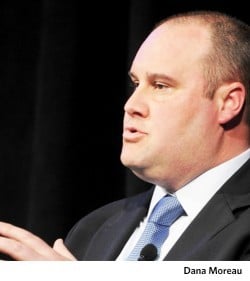Investors poured $2 trillion into emerging economies between 2009 and 2014. Then prices for a basket of commodities fell—dragging crude oil down to levels not seen in a decade and dashing investors’ hopes at the same time. What now?
At Commonfund Forum 2016, a panel discussion probed opportunities and risks in emerging markets. Excerpts from the panelists’ exchange follow. The discussion was moderated by Geoff Colvin, Senior Editor-at-Large for Fortune Magazine. The panelists were: Cate Ambrose, President and Executive Director, Latin American Private Equity and Venture Capital Association; Kun Deng, Managing Director, Lazard Asset Management; Dana Moreau, Chief Risk Officer, Commonfund; and Jui Tan, General Partner, BlueRun Ventures China.
INTRODUCTION
Geoff Colvin: Long term, emerging markets seem to be a high volatility/high reward investment. If you had invested $100 in January 2001, you would have $294 in January 2016. Yet, the compound annual return on emerging markets over the past decade is only 2.2 percent, with the last three years in negative territory. So, what should those responsible for long-term institutional funds be thinking about these emerging economies and should they be investing in them? That’s our topic, and we are going to pursue insights and information from our panel.
BRICS
Colvin: Kun, one popular emerging markets concept was the so-called BRICs, or Brazil, Russia, India and China. Does it even make sense today to think of the BRICs as meaningful concept?
Kun Deng: Not any more. It used to be the case when emerging markets were a big bloc to invest in and it was easy to divide the bloc into four big countries. Today those four countries are quite different from each other. If you look at population, for instance, China and Russia are aging, whereas India and Brazil are much younger. China and India are importers, whereas Russia and Brazil are exporters. The stage of economic growth is quite different—India is at least about 20 years behind China. You can look at India’s infrastructure compared to what you see in China. The BRICs are just completely different. Today’s emerging markets are really very diverse.
Colvin: Another obvious difference among the BRICs is that even though China has slowed it’s still growing very fast by most standards. India is growing even faster. The other two are in recession.
Deng: Absolutely. India is actually one of the fastest growing countries right now. If you look at China, all you hear from the media is that there is a severe slowdown. But the point to be aware of is that the slowdown is taking place in industrial China, the natural resources China related to mining, cement and steel. That’s the China of the last few decades. The consumption China, the service China, the new China—that’s booming.
OLD CHINA, NEW CHINA
 Colvin: Jui, this is a theme that I know you think a lot about. And, in fact, we do see many such examples. Tim Cook said you’d never know there was a slowdown in China, judging by Apple’s results. What is the difference that investors should understand between the old China and the new China?
Colvin: Jui, this is a theme that I know you think a lot about. And, in fact, we do see many such examples. Tim Cook said you’d never know there was a slowdown in China, judging by Apple’s results. What is the difference that investors should understand between the old China and the new China?
Jui Tan: I was investing as a venture capitalist in Silicon Valley 10 years ago. Then, when I moved to Beijing, the focus of the government, as well as business people, was on housing. So, there was this big run-up in the property market, as you know. To build houses, you need cement and steel and you need to buy land. So, that’s where the focus was—on building the infrastructure. But now, after 10 years, China has an emerging middle class of about 300 million people. I once invested in companies providing Internet services to lower income groups, what we might call migrant workers. Now, it’s all about investing in innovative mobile services to address the needs of the middle class. All this talk about a slowdown in China reflects the old China, the old economy, not the new economy that is focused on retail, financial services and health care.
LATIN AMERICA
Colvin: Cate, I want to ask you about the environment in Latin America because I suspect that this theme of change plays out there as well.
Cate Ambrose: For certain. It’s not really accurate to think about Latin America as one region or one market in terms of opportunities or risks. The main investable markets, certainly from a private equity or real assets perspective, are Brazil, Mexico, Peru, Colombia, Chile and, recently, Argentina. Within that set of markets we’ve seen most of the investment focused on Brazil and Mexico. Brazil has typically captured about two-thirds of fund-raising and private equity investing in Latin America. Brazil today is in a very deep economic recession and a profound political crisis. But we see a whole set of investors—strategic investors, pension funds and sovereign wealth funds—that believe in Brazil today and are actively moving in because of the long term opportunity and the country’s powerful demographics.
Mexico is another example of why you can’t think of Latin America as one region. The current administration has pursued some very interesting reforms in energy and telecom, it has a large manufacturing base and it’s highly correlated with the U.S. economy. In Argentina a very pro business president, Mauricio Macri, recently came into office. It may be a little early to get in because there’s a very ambitious reform agenda underway, but President Macri in the space of a couple of months has revitalized the central bank, removed capital controls and is settling with bond holders.

— Cate Ambrose
RISK MANAGEMENT
Colvin: Dana, this gets to the issue of risk. We’ve seen valuations go way down over the last couple of years, which could be regarded as a buying opportunity … or it could be regarded as the market foreseeing more trouble. How should investors think about risks in these countries?
Dana Moreau: Recent headlines have brought risk back to the forefront for investors. It’s right to strike a balance between risk and reward and you’ve heard a lot about the opportunity set from my colleagues here. It’s very important to go back to that point of differentiation and get past the headlines and the China chatter. While the risk in China is a real concern given that recent data has not been all that positive, it’s still important to understand that there are opportunity sets in different countries and different regions that justify the risk as long as you’re properly measuring the potential reward. Timeframe is an important consideration. Some pundits remain bearish on Argentina and Brazil right through 2017 and 2018, but some managers are already investing.
One other thing that we believe is important—and most of our managers think this way as well—is that there isn’t a pound-the-table time to get into or out of any asset class … a “sell it all” or “buy it all” mindset. Operating that way tends to diminish returns for institutional investors. We believe it’s important to have an understanding of your risk tolerances and allocate assets within bands, which allows you to express a view or capture an opportunity without acting like a macroeconomic trader.
OPPORTUNITIES IN CHINA
Colvin: Jui, where are you finding the best opportunities in China right now?
Tan: Xi Jinping is reforming the health care system. One change is to allow doctors to practice outside of public hospitals. China has close to 4 million doctors and they all work for public hospitals. Now, they are separating the actual medicine from the service delivery and that is going to present opportunities for start-ups. We have a portfolio company that has developed an online platform for Chinese doctors to provide instantaneous service to 70 million users instead of having them go to a public hospital and queue up for half a day.
We are also very bullish about the finance sector. Banks in China are all state owned and they have not been able to address the needs of SMEs (small and medium-sized enterprises). Now, we are seeing a lot of new companies that are leveraging technology to channel capital from individuals and corporations to the SMEs.
Colvin: Cate, how about Latin America?
Ambrose: People tend to think of Latin America as a region of natural resources with a focus on mining and energy. In fact, domestic consumption has been an enormous part of the story for almost a decade. Two of the largest deals in the region recently were in health care and education. In education, for example, few people know that the largest private education company in the world is Kroton Educacional in Brazil, which was backed by two private equity firms. People have heard of DeVry here in the U.S., and it has been expanding actively in Brazil in recent years. In financial services, Sequoia has backed a fast growing start-up called Nubank , a mobile-based credit card business that reaches people who don't have bank accounts.
TOP-DOWN VERSUS BOTTOM-UP
Colvin: How should institutions invest in emerging markets—top down or bottom up? Should you just decide on a good market and buy the index because you’re going to be holding it with a perpetual time horizon, or should you really try to be picking winners?
Deng: You really have to understand what’s happening on the ground in a country. In Russia, for instance the headlines scared investors away and that’s where the opportunity is for on-the-ground investors like us. Russia was the second best performing market last year. Headlines out of Brazil would scare away investors, but one of our investments was up 30 percent last year. At the end of the day, you have to realize that one plus one doesn’t always equal two.
 Moreau: Earlier, I mentioned allocating within strategic bands, building ranges around a strategic allocation. Once your investment committee agrees on the bands I don’t believe you should waiver without a documented change to your policy. Those bands are there to protect you from making poor decisions at the bottom of a market or at the top. Having those bands in place and moving at the margins is how you can express a top-down view. Currency risk should be considered as well because it can be big driver of return and volatility.
Moreau: Earlier, I mentioned allocating within strategic bands, building ranges around a strategic allocation. Once your investment committee agrees on the bands I don’t believe you should waiver without a documented change to your policy. Those bands are there to protect you from making poor decisions at the bottom of a market or at the top. Having those bands in place and moving at the margins is how you can express a top-down view. Currency risk should be considered as well because it can be big driver of return and volatility.
From a bottom-up perspective, I go back to active management. I think the ultimate bottom-up applications are the private capital and hedge fund managers who are on the ground, as Kun mentioned. We’re looking for managers who are uncorrelated so we can minimize overlapping risks within the portfolio. Managers change over time, so it’s important to measure them continuously and make sure that they’re doing what they signed up to do. On the qualitative side, we follow managers for a long time and really get to know them and their entire team—legal, compliance, risk, operations, not just the investment team.

- Kun Deng
CONCLUDING THOUGHTS
Colvin: To conclude, what are the most important issues facing long-term institutional investors when they think about emerging markets?
Ambrose: I represent just one region, but I would say that there is an extraordinary opportunity right now in some markets in Latin America because of the dramatic currency devaluation we’ve seen. In 2013-14, the Brazilian real was at two to one with the U.S. dollar. It’s now at four to one, and some people think it could go to five. Imagine what that means if you have dollars today and you’re starting to look at a market like Brazil. So, there is opportunity, but you have to be very selective and that is the other piece of it, because some of those businesses were created in boom years at a very different currency exchange rate and they are simply not going to be successful.
Tan: China is a fast-growing economy, so if you make an investment in venture capital and pick the right manager you should be able to get a good return. But the one similarity between the U.S. and China is that you’ve got to find a manager who is able to take money off the table at the right time because there are a lot of unicorns in China. There is money going into venture capital in China and the risk is a big run-up in valuations. But the next moment the public market may go south and funding dries up for companies that don’t have a good business model. My advice is to pick savvy managers who will take money off the table at the right time.
Moreau: I certainly agree with picking astute, experienced managers. But, we should note, taking money off the table at just the right time is market timing and hard to do. In Latin America, if your manager is making a call on currency, that’s a risk you must factor into your analysis of the investment. Making currency bets requires a very different skill set than fundamental company research. I believe a more enduring approach is to determine your risk tolerance, align your investments with your policy guidelines and measure the sources of risk within your portfolio rather than relying on short-term tactical moves to generate alpha.
Deng: One of my most favorite books is War and Peace by Leo Tolstoy, in which he says, what ultimately wins the war is not really how brave the soldiers are or how advanced the weapons are, but two things—time and patience. That’s what you need in emerging markets.

